The Nikkor Z 24-70mm f/2.8 S lens has the Nikon Z mount and is designed for use with Nikon’s new mirrorless cameras. It sits alongside the Nikkor Z 24-70mm f/4 S, which was introduced with the Z 7, and is designed to appeal to professional and dedicated enthusiast photographers who want to restrict depth of field more than is possible at f/4, or enjoy an extra stop of light.
Its 17-element, 15-group construction includes two ED (low-dispersion) elements and four aspherical elements. Along with its Nano Crystal coating, Nikon uses its new ARNEO anti-reflective coating, which is said to suppress flare from light traveling perpendicularly through the lens (the Nano Crystal Coating is designed to deal with those issues arising from multi-directional light). The 9-blade aperture is rounded for attractive bokeh.
Nikon uses an internal focusing mechanism so the lens doesn’t change length during focusing. There are also weatherproof seals, and the front and rear elements have a fluorine coating to help repel dust, fingerprints, and water droplets.
Unusually, the lens has three rings, one each for zooming and focusing manually, and the third for adjusting a custom parameter such as aperture or exposure compensation. (Users set the desired parameter via the camera’s menu.) There’s also a small OLED screen which can show information such as the precise focal length, the selected aperture, or a depth-of-field guide.
Key specifications:
- Full-frame format
- Available in Z-mount only
- Aperture range f/2.8–f/22
- 82mm filter thread
- Minimum focus distance: 38cm (14.96”)
- Weight: 805 grams (1.77lb)
Overall lens image quality
Whereas the Nikkor Z 24-70mm f/4 S is designed to be small to complement the scale of Nikon’s mirrorless cameras, the Nikkor Z 24-70mm f/2.8 S is intended as a superior-quality optic that’s optimized for image quality.
When mounted on the high-resolution 45.7MP Nikon Z 7 camera, the Nikkor Z 24-70mm f/2.8 S achieves an overall score of 36. That means it is the best 24-70mm lens we have tested to date. It’s also the fifth-highest-scoring zoom lens in our database. Its sharpness score of 26 is also a significant step up from the Nikkor Z 24-70mm f/4 S. Like the f/4 optic, the Z 24-70mm f/2.8 S maintains its sharpness well across the image and throughout both the focal length and aperture ranges.
At the extreme ends of the focal length range, there’s noticeable distortion. However, this is largely corrected by the built-in RAW profile that is applied when images are processed. There are also in-camera corrections that can be applied to JPEGs. When these are turned off, the distortion is visible in JPEG images of architecture or similar scenes that have a strong linear element, but simultaneously-captured RAW files are corrected.
A score of –2.1EV for vignetting indicates that corner shading is also apparent in images shot with the aperture wide-open. However, the fall-off is fairly gradual.
The lens’s transmission score of 3 is reasonably good—better than Nikon’s other zoom lenses, but it’s behind the Canon RF 28-70mm f/2L USM and the Sony FE 24-70mm F2.8 GM, which score 2.2 and 2.8, respectively.
Image quality compared to its competitors
Click here to open our interactive DxOMark lens comparison tool.
While a sharpness score of 26 is very good, it’s not up to the standard of the Canon EF 24-70mm f/2.8L II USM on the 50Mp EOS 5DS R, which achieves a very impressive score of 32. However, a score of just 5 microns for chromatic aberration places the Nikon lens among the very best zoom lenses that we’ve tested. (The lowest figure we ever recorded with a zoom lens is 2 microns for the Canon EF 200-400mm f/4L IS USM Extender 1.4x.)
Despite being beaten by the Canon EF 24-70mm f/2.8L II USM for sharpness, the Nikkor Z 24-70mm f/2.8 S sits above the Canon optic because of its far superior control of chromatic aberration and marginally better distortion figures. Similarly, the Sony FE 24-70mm f/2.8 GM has slightly better sharpness, vignetting, and transmission scores, but it is let down by its control of chromatic aberration, which although good, doesn’t match that of the Nikon lens.
Many photographers contemplating a move to a Nikon full-frame mirrorless camera will be trying to decide between the Nikkor Z 24-70mm f/2.8 S and the Nikkor Z 24-70mm f/4 S. A glance at the table above reveals the headlines for image quality: the f/2.8 optic is superior in every aspect apart from vignetting—but of course, the difference in the maximum aperture comes in to play. At 24mm and f/4, the Z 24-70mm f/2.8 S creates less corner shading than the Z 24-70mm f/4 S.
In-depth comparisons
For a more detailed look at the image quality from the Nikkor Z 24-70mm f/2.8 S, we will compare it with the Nikkor Z 24-70mm f/4 S and the Sony FE 24-70mm f/2.8 GM. The Nikkor Z 24-70mm f/4 S is the closest competitor for a Nikon Z-mount photographer’s attention, while the Sony lens is a popular choice among photographers with Sony full-frame mirrorless cameras.
Sharpness
Our lens database allows you to review the results from our tests of different lens attributes. Looking at the sharpness results, you can examine the acutance figures obtained at different focal lengths and aperture values—and they reveal some interesting differences among the tested lenses.
The graph below shows how the lenses compare at 24mm with the aperture wide-open. The Nikkor Z 24-70mm f/2.8 S is the clear leader, producing sharper results and better sharpness across the frame. That’s good news for anyone wishing to separate their subject from the background or wishing to use fast shutter speeds in low light without pushing the shutter speed up too far.
Closing down the aperture to f/22 and zooming in to 50mm reveals a rather different picture. Diffraction has reduced the acutance across the board, but the Sony FE 24-70mm f/2.8 has a slight lead and the results from the two Nikon optics are nearly identical.
Generally, the Sony FE 24-70mm f/2.8 is sharper than the Nikkor Z 24-70mm f/2.8 S at longer focal lengths and when the aperture is closed down. However, it has a bit more variation across the field, and this confuses the story. At 50mm, for example, the Sony lens is slightly sharper at the center than the Nikon f/2.8 optic. However, by 40% of the distance to the edge, the Sony lens’s sharpness has dropped below that of the Nikon lens.
Chromatic aberration
Like the Nikkor Z 24-70mm f/4 S, the Nikkor Z 24-70mm f/2.8 S uses a built-in correction profile to reduce lateral chromatic aberration visible in RAW files. We measure the chromatic aberration without this applied, but it’s not possible to turn it off in normal use. As a result, our measurements indicate that the lens produces more chromatic aberration than you are likely to see in your images.
Even taking this into account, the Nikkor Z 24-70mm f/2.8 S controls chromatic aberration very well. It’s most likely to be visible at the shortest focal length when the aperture is closed down.
The graph below shows the results at 24mm and f/11. Although one of the two lines shows quite strong fringing at the farthest edge of the image, it is less than –5 microns at 40% from the center of the frame, and only just slips beyond –5 microns at 60%. This means that the chromatic aberration isn’t really an issue for much of the image. The chromatic aberration caused by f/4 Nikon and Sony lenses is likely to be visible across more of the image.
Geometric distortion
Again, we took our measurements without the correction profile that is automatically applied to RAW files, which means that your images may show less distortion than our measurements indicate. (It’s possible to turn the in-camera corrections off for JPEGs, and they show more distortion when you do.)
At 24mm, the Nikkor Z 24-70mm f/2.8 S shows a little more barrel distortion than the Sony lens, but is better than the f/4 Nikon optic. By 35mm, the distortion has switched to pincushion, but it’s unlikely to be problematic. At 50mm and 70mm, levels of distortion increase slightly, but are lower than on the f/4 lens.
Vignetting (corner shading)
The Nikkor Z 24-70mm f/2.8 S suffers from a similar level of vignetting as the Nikkor Z 24-70mm f/4 S, with both optics creating corners that are more than 2EV darker than the center of the image at the widest focal length and aperture. However, as the gradient of the lines in the graph below shows, the fall-off is quite gradual. While having 0.5EV shading at 60% from the center of the image may not be ideal, it means that the transition in the exposure is smooth and quite natural in appearance.
By f/8, the corners in images captured using the Nikkor Z 24-70mm f/2.8 are less shaded than those from the Sony lens. However, the aperture needs to close to f/11 before the corner shading drops to just below 1EV at 24mm. At 35mm, it’s f/8, and by 50mm, it’s f/5.6.
Conclusion: The new benchmark for 24-70mm lenses
Many professional photographers consider their 24-70mm f/2.8 their standard, everyday workhorse optic. The Nikkor Z 24-70mm f/2.8 S sets a new benchmark by which other 24-70mm lenses will be judged.
It may not have the record for the highest sharpness score, but it manages to maintain its excellent sharpness very well across the frame. The distortion, which isn’t excessive, is also corrected automatically in RAW files and its control over chromatic aberration is superb.
The degree of vignetting is perhaps a little disappointing, but it can be addressed in post-capture processing if necessary, and many photographers like to darken image corners to enhance their images. If you want the best all-around image quality from a 24-70mm lens, the Nikon Nikkor Z 24-70mm f/2.8 S is the lens to go for.
In this review, we have compared the Nikkor Z 24-70mm f/2.8 S to its closest rivals. Remember that the lenses are intended to be used on different camera systems and mounts, so the comparisons are not strictly applicable.
As usual, you can create your own comparisons and in-depth analyses using our interactive image lens comparison tool.


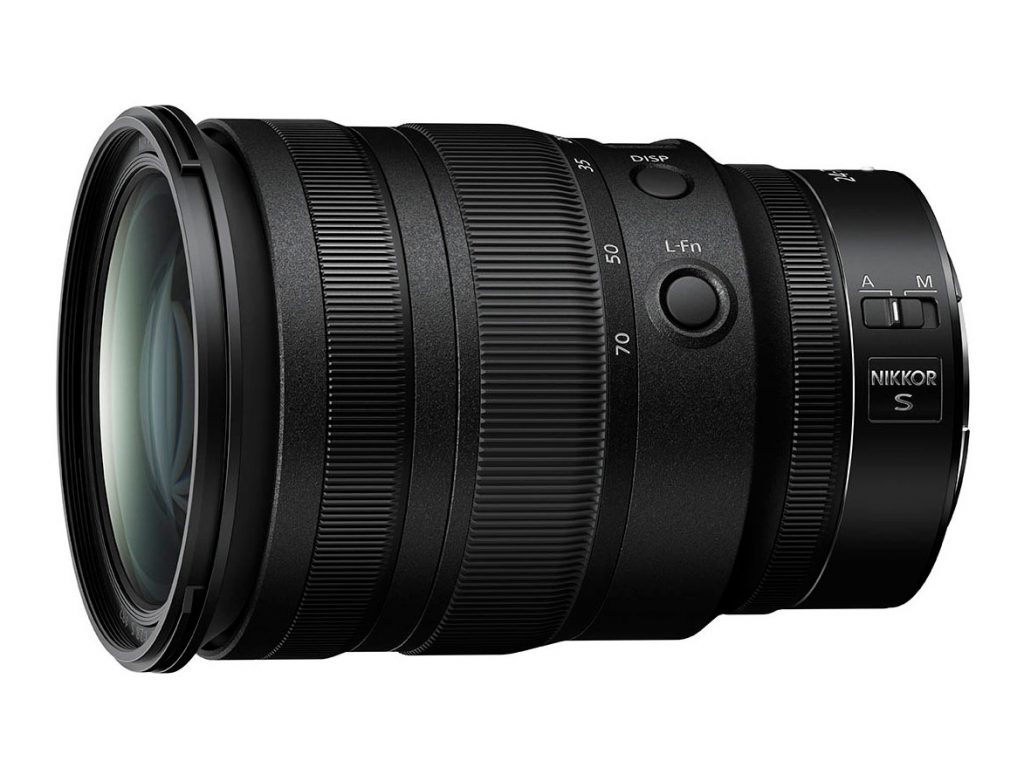


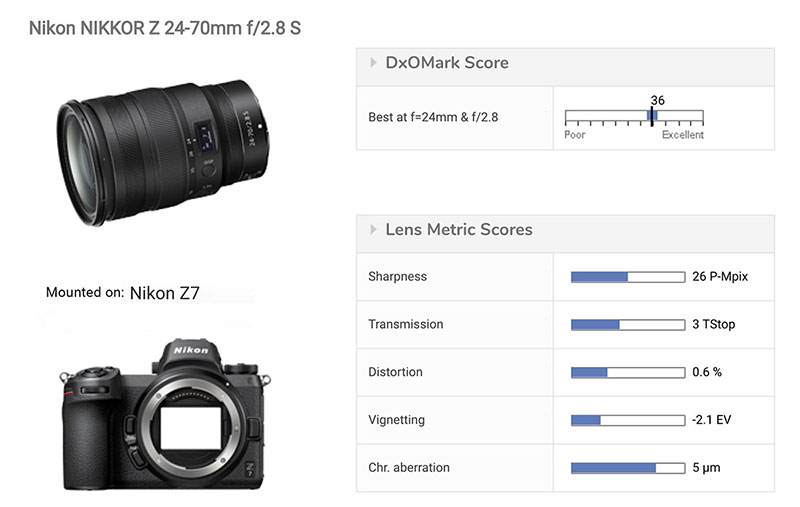
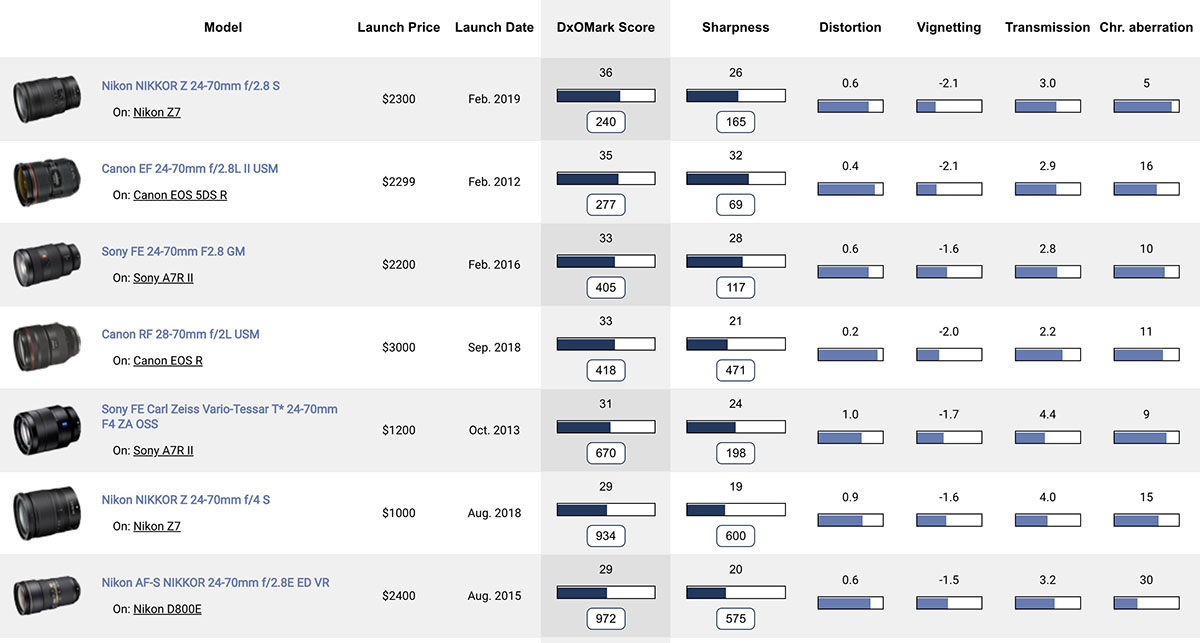
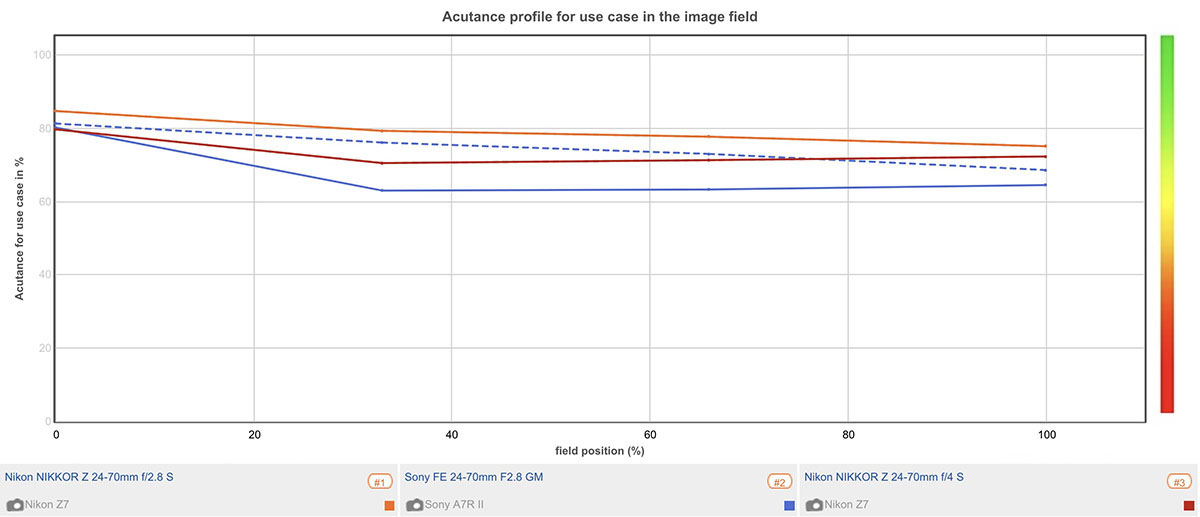
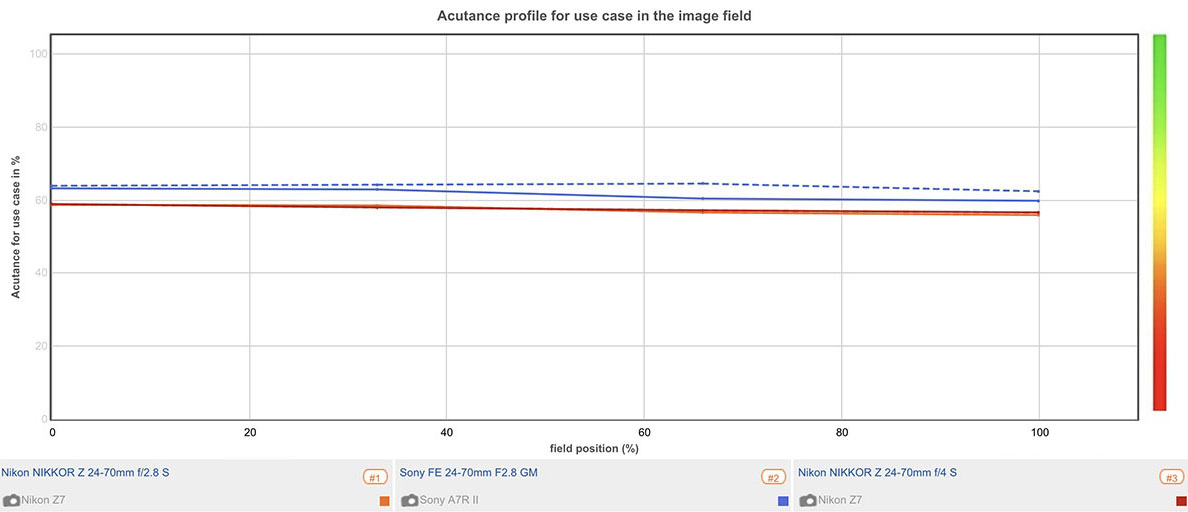

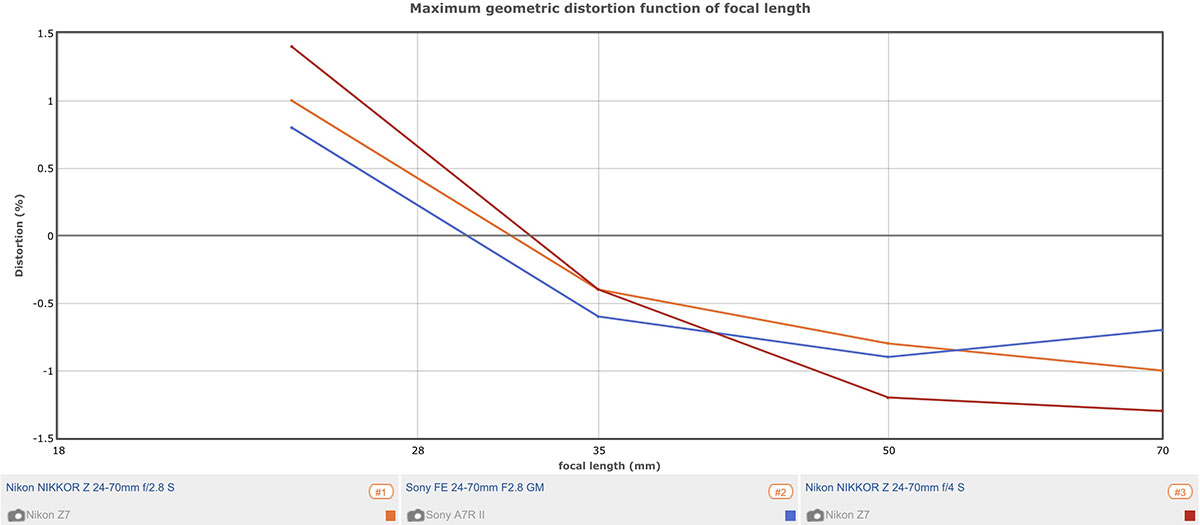
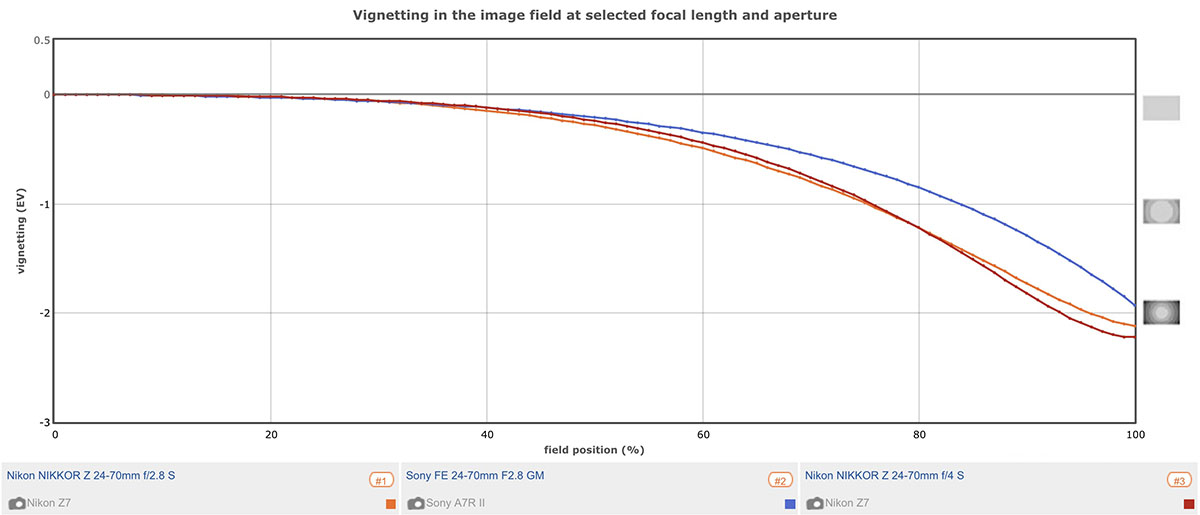


DXOMARK encourages its readers to share comments on the articles. To read or post comments, Disqus cookies are required. Change your Cookies Preferences and read more about our Comment Policy.